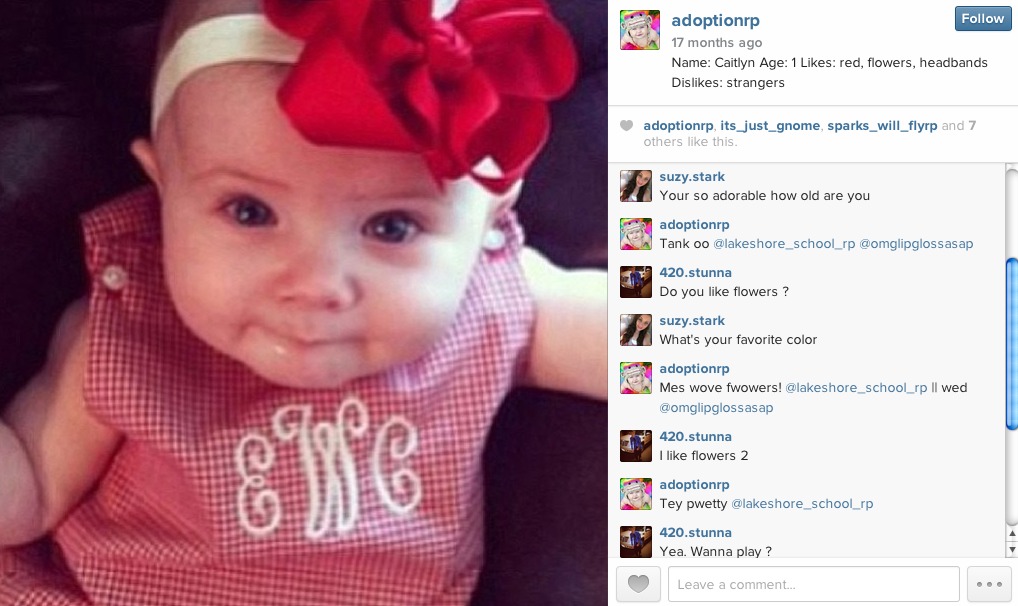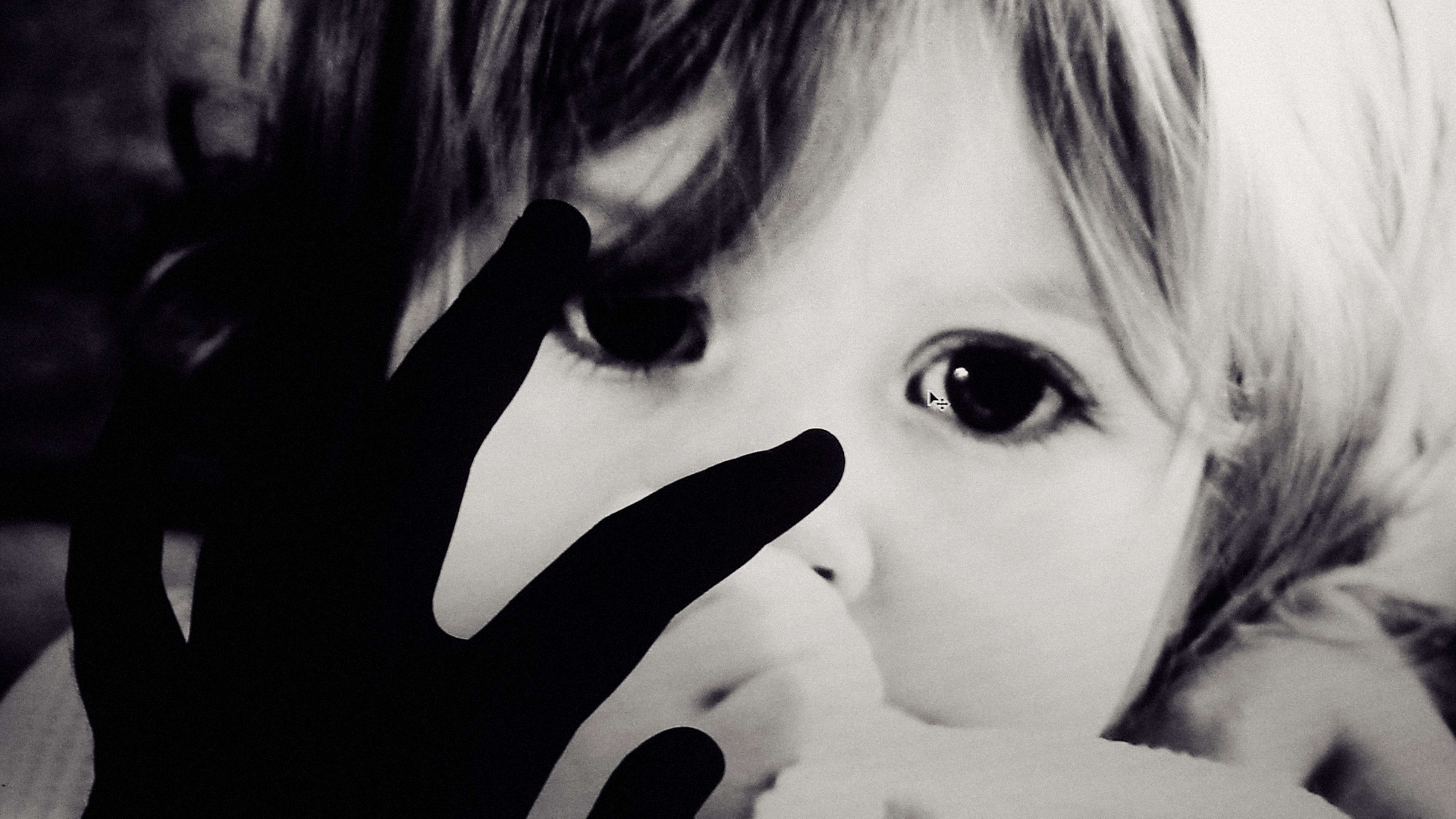The followers were the first sign of trouble. There were 20 new ones following Jenny on Instagram–an unusually large burst of attention for the married mother of three from Charlotte, North Carolina. Then two private messages arrived, with warnings that barely made sense. “The women told me they saw a photo of my baby daughter, and a user named ‘Nikki’ was saying it was her son, Wyatt,” says Jenny, who, concerned for her privacy, asked that her last name not be used. “Nikki said he was a preemie, she gave his weight, length, everything. All made up.”
Jenny had become a victim of a growing–and to many, alarming–new community that exists primarily on Instagram: baby role-players. Instagram users like Nikki steal images of babies and children off the Internet, give them a new name, and claim them as their own. Sometimes they create entire fake families. Others then interact in the comments of each photo, role-playing as they virtually feed, burp, swaddle, and even reprimand these virtual children. Some Instagrammers even portray themselves as virtual adoption agencies, where followers can request specific babies and toddlers they’d like to adopt–“Looking for a two-year-old girl with blonde hair, green eyes, and who is feisty”–and the adoption agency then finds a photo, usually without permission. Role playing ensues.
What does that role-playing look like? Mostly like this:

That baby, according to the account @adoptionrp, is a one-year-old named Caitlyn. Users chime in to ask the baby questions (“Do you like flowers?”), and @adoptionrp replies as the baby (“Mes wove fwowers!”). And . . . that’s usually it. Though on some accounts the play takes on a more malicious tone, as with the account @adoption_rp, where roleplaying often features an obsession with breastfeeding and being “nakey.”
There’s little recourse for those whose photos are stolen. When Jenny contacted Instagram for help, the company seemed not to understand the problem. “I explained that this private user had stolen photos of my infant daughter,” she says. “Their response was that this was impersonation of a minor and I should be reporting that a minor is using Instagram. I wrote back and said this is not a minor using Instagram. She claims she’s 14 and she’s using a picture of my baby and other babies. They never responded.” (Instagram didn’t reply to a request for comment from Fast Company.)
Some Instagram users have also tried raising awareness, but they haven’t gotten far. A Change.org petition to ban the role-playing accounts got only 1,047 signatures.
Most of the major role players are anonymous, so it’s not clear who they are or how to reach them. But those who do reveal themselves are almost always teenage girls. Oftentimes, tween and teen role players like these come from a broken home, where their parents are either divorced or the child has been abused, says psychiatrist Gail Saltz. “The idea that an adolescent can create an identity online and take advantage of that anonymity does not surprise me,” says Saltz, author of Anatomy of a Secret Life: The Psychology of Living a Secret Life. “It’s more exciting to be testing these fantasies online and not in their minds because there’s some follow through online and yet they’re behind the safety of their computer in their bedroom. This is another variation of that. These role players have a desire to try on the fantasy of being a family person, a mother, whatever it might be that they’re searching for or void they’re trying to fill.”
When regulated, baby role-playing comes off as a lot less threatening. That’s the case on BabyNames.com, a website where users can search for potential baby names. Role-playing was popping up on the site’s message board, which left its founder and CEO, Jennifer Moss, with a choice: either shut the conversations down, or find a way to keep them innocent. She chose the latter. The site created a board titled “Fantasy Families,” where a group of moderators patrols for violations of the most important rules: no fake photos, and no abusive talk. “It’s a digital version of playing house,” says Moss. “They can indulge in their need to play act. They could live out their fantasy in a non-confrontational way.”
Unsurprisingly, role players from a regulated space like BabyNames.com are also a lot more willing to explain themselves. Trisha Larson, 37, has been a member of BabyNames.com since its inception. She remembers being four years old and dreaming of having a sibling. Then it happened. “I loved babies–they were cute and fun–but my sister was not a cute, fun baby. She was colicky and she screamed most of the time,” Larson says. So the toddler began imagining happy babies and cute homes. It’s a pleasure that hasn’t left her, even though she’s now a married mom of four. On Babynames.com, she says, “You could post photos of what your dream house looked like, what your baby nursery would look like, what clothes you would bring your baby home in from the hospital.”
Certainly, there’s plenty of that innocence on Instagram as well–but with no policing of stolen photos, the fantasies on the social media giant often come off as more concerning. The parents of those real children and images often feel violated.
That’s still how Jenny feels. She tried confronting “Nikki,” the user who stole her daughter’s photo, but Nikki just responded by changing her username. Jenny says Nikki has changed it dozens of times, and that the few people who have made contact suspect that Nikki is probably a tween.
The experience has made Jenny re-evaluate what she puts on the internet. Jenny had kept a blog about her problems with infertility. Eventually it morphed into a pregnancy diary, in which she detailed the premature birth of her triplets. That’s where Nikki took the photo from. “I was focused on sharing my story as part of a community with parents of preemies and infertility survivors,” Jenny says. “I thought I was doing something good. It turns out I was putting my kids out there in a negative fashion. I still can’t even wrap my head around it.”
Update: Following the publication of this story, Instagram sent following statement: “This type of content violates our terms. Once a parent or guardian reports it to us, we work quickly to remove it.”
Recognize your company's culture of innovation by applying to this year's Best Workplaces for Innovators Awards before the extended deadline, April 12.
